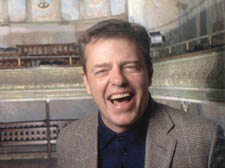|
|
 |
| |

Suggs inside Wiltons Music Hall during his tour of 'disappearing' London |
‘In mad rush to the future, important things get lost’
Madness singer Suggs’s book about the capital laments the effects of progress on a city that ‘isn’t what it used to be’,
writes Simon Wroe
Suggs and the City: My Journeys through Disappearing London. Headline £18.99.
ACCORDING to Samuel Johnson, when a man is tired of London, he is tired of life. So what, to take the analogy the other way, would the good Dr Johnson have made of Suggs?
Few bands have anchored themselves so surely to a place as Madness have to London, and perhaps no frontman has sung the praises of this heaving metropolis (or any city for that matter) quite so ardently.
But it seems name-checking Somers Town, Arlington House and Camden Town in song or producing concept albums about obscure quarters of the capital (this year’s acclaimed The Liberty of Norton Folgate) are not enough for the 48-year-old singer. Suggs and The City, a book about London’s venerable, debauched and vanishing institutions, cements the relationship between the two.
Suggs describes the book as a celebration of “people and places that have floated into my firmament while they’re still around, and to remember others that have already disappeared from the map”.
The roll call is exhaustive; but what distinguishes this from other literary offerings in the same vein is the author’s personal, often slightly illicit connection with much of his subject matter. He describes his early (uninvited) excursions to the Groucho Club, via the drainpipe of the neighbouring Colony Club and the ladies’ toilets, which ended abruptly when he broke the pipe, fell into the alley beneath, covered himself in sewage and flooded the adjacent Chinese restaurant.
The Camden Palace, now Koko, is another of the singer’s favoured break-ins. In the 1970s, he and Lee Thompson, who would become Madness’s saxophone player, would sneak in through a hole in the Palace’s copper dome roof when they were hard up.
“Congratulating ourselves on the daring of our enterprise, we sauntered into the room whereupon it was immediately clear that many of the other guests present were somewhat startled by our appearance. When I looked at Lee and he at me, we realised we were covered in pigeon dung. Not an auspicious entry into such a fine building,” he writes.
For Suggs, The Palace also “shelters Cupid somewhere in the rafters” – hopefuly free of bird poo – as it is where he met his wife, Anne, whom he married in Kentish Town when he was 21. They have been together ever since and have two daughters, Scarlett, 26, and Viva, 24.
Like many of London’s greatest admirers, Suggs (real name Graham McPherson) was not born here. Hastings holds that particular accolade. From there, a young McPherson moved about England with his mother before settling in a flat in Tottenham Court Road. It might not have been the rowdy heartland of Camden Town, but it was close enough. And it was in Camden Town, at the Dublin Castle, where Madness got their first gig. They had to lie to get it, telling the landlord they did “jazz and a bit of country and western”.
Suggs’s initiation into the city’s peccadillos came even earlier though: from the age of seven his mother would take him to the Soho drinking dens where she worked as a club singer. The singer is obviously pained by the disappearance of those clubs and music hall acts. “Sometimes in the rush to the future, important things get lost along the way,” he writes.
But this is a shotgun tour through London’s great, filthy underbelly – there is little time to be down in the mouth. We meet Alf Masterson, the last rag-and-bone man who trawled the streets of Highgate in search of lost treasures until he died in 2007; try to fill the drinking boots of Daniel Farson, a Soho writer whose Telegraph obituary described him as “a monstrous drunk”; and gawk at über-dandy Beau Brummell who polished his boots with champagne. We visit the haunts of Soho, the Bermuda Triangle for many an artist and writer, and we are plied with fascinating trivia.
Did you know the wearing of top hats is still banned in London after its inventor, John Hetherington, first wore one in public in 1797? The spectacle started a riot – officers reported “several women fainted at the unusual sight, while children screamed [and] dogs yelped”. Hetherington was fined £50 for wearing “a tall structure having a shining lustre and calculated to frighten timid people”.
These lost worlds might make the reader misty-eyed. But don’t be too heartbroken: Suggs reserves the words of Ian Board, owner of Soho’s infamous Colony Club: “It never was what it f***ing used to be!” |
 |
|
|
 |
 |
|
 |
|


